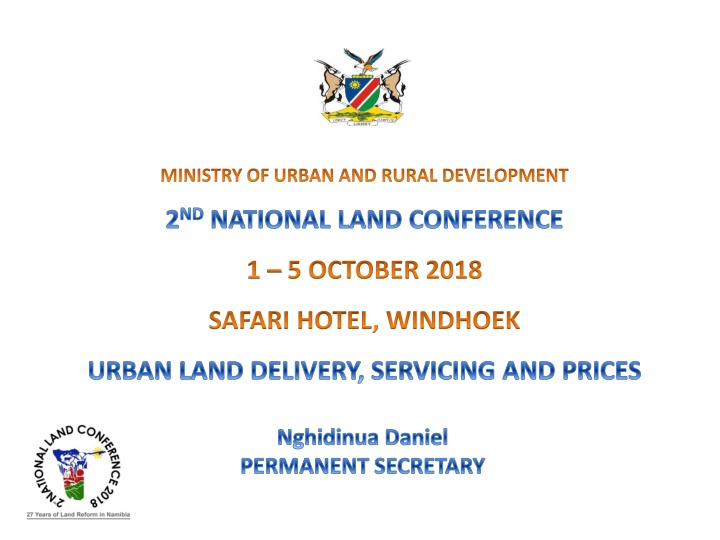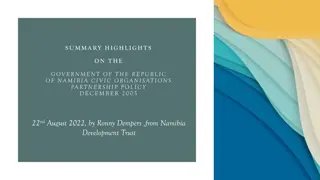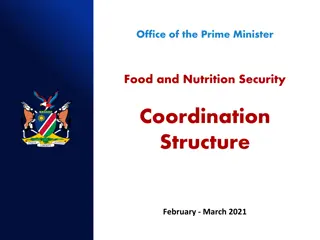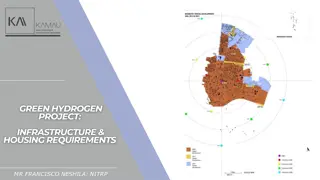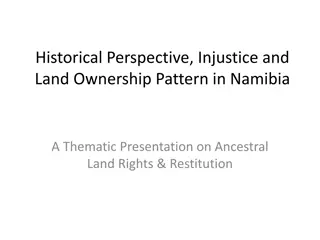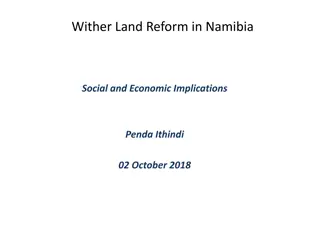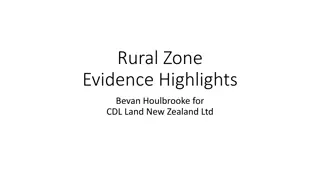Challenges and Solutions in Urban Land Delivery and Pricing in Namibia
The Urban Land and Housing Sector in Namibia faces significant challenges such as a backlog in land delivery, high input costs, weak urban planning, and limited institutional capacity. These issues lead to slow supply rates and affordability problems for end users. Addressing these challenges requires integrated urban planning, streamlined administrative procedures, and improved coordination between government entities. By tackling these issues, Namibia can enhance urban land delivery, servicing, and pricing to meet the growing demand for serviced land and housing.
Download Presentation

Please find below an Image/Link to download the presentation.
The content on the website is provided AS IS for your information and personal use only. It may not be sold, licensed, or shared on other websites without obtaining consent from the author.If you encounter any issues during the download, it is possible that the publisher has removed the file from their server.
You are allowed to download the files provided on this website for personal or commercial use, subject to the condition that they are used lawfully. All files are the property of their respective owners.
The content on the website is provided AS IS for your information and personal use only. It may not be sold, licensed, or shared on other websites without obtaining consent from the author.
E N D
Presentation Transcript
MINISTRY OF URBAN AND RURAL DEVELOPMENT 2NDNATIONAL LAND CONFERENCE 1 5 OCTOBER 2018 SAFARI HOTEL, WINDHOEK URBAN LAND DELIVERY, SERVICING AND PRICES Related image Nghidinua Daniel PERMANENT SECRETARY
Related image OUTLINE Legal framework Land delivery process Urban land pricing Conclusion & recommendations
Related image CONTEXT The Urban Land and Housing Sector in Namibia is characterised bya huge backlog in the supply of and demand for serviced land and housing in urban areas in particular and the country in general. This state of affairs is attributed to a combination of factors. These are the high rate of rural-urban and urban-urban migration population growth and demographic changes as well as poverty and economic growth levels. (urbanization),
Related image Challenges (Backlog) Causal Factors: 1. Low or slow delivery or supply rate due to: High input costs; Weak or lack of integrated and pro-active urban planning (master plans); Cumbersome or lengthy administrative and legal procedures of acquisition,planning and development of urban land (proclamation of townships, surveying, subdivision, servicing, disposal and registering of immovable property); Limited or weak institutional and technical capacity (urban/town planners, surveyors, engineers, etc.) at the Central and local government;
Related image Challenges (Backlog) (cont..) Causal Factors 1. Low or slow delivery or supply rate due to (cont..): Heavily reliance on conventional construction materials, technologies and methodologies; Slow or delayed execution of projects; Overlaps or lack of clarity between the jurisdictions of Government (Central, regional and local) and traditional authorities resulting in conflicts and disputes and consequent delays in execution of planned capital projects in some cases; and Local authorities having reached their set townland boundaries and no longer have any land to service and provide, requiring the acquisition of either communally occupied or privately owned farmland (compensation).
Related image Challenges (Backlog) (cont..) Causal Factors 2. Affordability by the target end users: A mismatch between the types and pricing of housing products that are available in the market on the one hand and the needs and affordability levels of a large section of the needy on the other hand, especially the low to middle income earners; Limited affordable housing financing facilities especially for the low to middle income groups; The stringent and rigid lending requirements of the financial market that require collateral security, and the inability of the low and lower income earners to meet such financing requirements; Unemployment and poverty, which reduce potential buyers purchasing power; Overpricing and speculative activities by some developers due to a lack of enforcement of regulatory controls on pricing; Unclear or lack of transparency and inclusivity in the manner or methods in which land (serviced or un-serviced) that is earmarked or available for sale by local authorities is communicated to the broad public.
Related image Legal Framework Local Authorities Act, 1992 (Act 23 of 1992) as amended Regional Councils Act, 1992 (Act 22 of 1992) as amended Town Planning Ordinance, 1954 (Ordinance 18 of 1954) as amended Town Planning Amendment Act, 1993 (Act 27 of 1993) Town Planning Amendment Act, 2000 (Act 15 of 2000) Townships and Division of Land Ordinance, 1963 (Ordinance 11 of 1963) as amended Townships and Division of Land Amendment Act, 1992, 1998 and 2000 (Act 28 of 1992, Act 21 of 1998 and Act 11 of 2000); Flexible Land Tenure Act of 2012 (Act No. 4 of 2012); Compensation Policy 2009, which provides for fair compensation to communal landholders
Related image Legal Framework (cont..) Town and Regional Planners Act, 1996 (Act 9 of 1996) as amended (Act 32 of 1998) Professional Land Surveyors, Technical Surveyors and Survey Technicians Act, 1993 (Act 32 of 1993) Engineering Profession Act, 1986 (Act 18 of 1986) as amended by Engineering Profession Amendment Act 25 of 1991 Traditional Authorities Act, 2000 (Act 25 of 2000) repealed Acts 17 of 1995 and 8 of 1997) Registration of Deeds Act, 1937 (Act 47 of 1937) as amended Urban and Regional Planning Act (Act No. 5 of 2018);
Related image Land development/delivery process Town Planning Mortgaging /registration Land Surveying Land Delivery Services construction Environmenta l Clearance Engineering services
Related image Land development/delivery process (cont..) The actual installation of basic municipal services is preceded by the following activities: Town planning (preparation of layout drawings); Surveying (preparation of General Plans showing pegs placement/cadastral boundaries); EIA assessment and clearance; and Engineering services (Designs of the over and under-ground services (sewer, water, roads and electricity) to be installed or constructed (land servicing).
Related image Urban Land Pricing Upset price Upset price is the price set with a view to recover the money spent on the development thereof. The following costs make up or are calculated into the price of an erf: Town Planning Cost Survey Cost Road and street name signs Basic earthworks and storm water drainage Tarring of streets Access roads Land cost Administration cost Open spaces/play parks
Related image Urban Land Cost and Pricing (cont..) The cost of developing a parcel of land (upset price) depends on several factors: Level of services required Soil formation Erf sizes Topography of the land to be serviced Proximity or availability of bulk services Location of the land to be serviced Interests on money spend Cost of materials Professional fees Services installation period
Related image OUTPUTS AND OUTCOMES Proclamations 42 new Local Authorities from 15 at independence 411 townships (extensions) proclaimed since independence translating into some 123,400 plots countrywide; Land Servicing 33,619 plots serviced during 2013/2014 to 2017/2018 FYs Housing Alienation Scheme - 4,000 houses were transferred/ sold to the tenants Build Together Programme (BTP) - 30,400 housing units have been constructed under this Programme since inception (1992)
Related image Conclusion & Recommendations Expedite the roll out of the Flexible Land Tenure System Massive Urban Land Servicing Project (MULSP) increased state investment Revision of the MHDP Blueprint and Implementation Strategy development; Enhanced community participation (demand-driven approach) - SDFN Enhance affordability for low income earners by among others: Providing for rental-to-own housing development as well; Adopting affordable incremental design/layouts andbuilding methods Pre-allocation of (un-serviced) - Land with only a few of the basic services (planned, surveyed and perhaps only serviced with sewer and water in the first phase and other services to follow later); and Introduction and enforcement of discriminatory pricing of land and cross-subsidisation.
Related image Conclusion & Recommendations (cont..) Encourage more PPPs in the servicing of urban land and housing in line with the provisions of the Public-Private Partnership Act, 2017 and on the basis of Clear pre-determined targets (beneficiaries, product types and prices); Open and competitive procurement; and Fair distribution of risk or costs and benefits between the Government and private developers; Regulation of the sale of land to private developers especially to prevent land speculation and sale of large tracks of land to a few individuals and developers; and Local authorities should develop appropriate institutional capacity to guide, monitor and ensure integrated land use planning and urban development as well as environment protection.
Related image Conclusion & Recommendations (cont..) Amend the Local Authorities Act, 1992 and the Regional Councils Act, 1992 to insert a provision prohibiting the sale of land to foreign nationals, and obliging those who are already in possession of urban land to give the State the first right of refusal when they want to bequeath; Continued role of Government (Central and sub-national governments) as a land provider for affordable housing targeting the ultra and low income groups; Implementation of Business Process Re-engineering (BPR) in the urban land and housing planning, approval and delivery processes at all levels;
Related image Conclusion & Recommendations (cont..) Continued financial and technical support to regional councils and local authorities as well as the NHE towards land and housing delivery with specific set conditions and deliverables such as: The target groups (low income and other considerations); Specifications (costs, sizes, etc.) of the products or services to be realized; and The establishment of dedicated revolving funds/accounts, to be audited periodically by MURD and the Office of the Auditor General, into which proceeds from the sale of serviced land and houses are to be deposited for re-investment; Development and/or enforcement of appropriate legal instruments that protect both landlords and tenants - Tenants against arbitrary rental increases and guarantees an agreed level of service and maintenance, and the right for the landlord to collect on delinquent rent and the power to evict non-compliant tenants;
Related image Conclusion & Recommendations (cont..) MURD with technical support from NSA to conduct a study onindigent people in urban areas who are not in possession to pay for municipal services with a view to enable government to develop a viable incentive scheme; MURD, with the support of the Ministry of Justice and Office of the AG, to expedite the finalisation and promulgation of the regulations to operationalise the Urban and Regional Planning Act, 2018; MURD in partnership with the Ministry of Industrialisation, Trade and SME Development and institutions of higher learning (UNAM and NUST) to carry out research and development with a view to identify and promote the manufacturing and use of cost-effective building materials and technologies that meet set quality and safety compliance standards;
Related image Conclusion & Recommendations (cont..) Local Authorities and Regional Councils, with support from MURD and other relevant authorities and agencies, to develop and put in place up-to- date database on available serviced and un-serviced urban land as well as verifiable lists of people in need or those who applied for serviced land and housing support; Government, through MURD and MLR, should finalise the review of the land compensation valuation and implementation guidelines in order to respond to current needs and developments in respect of land acquisition and compensation; A revision of the current role and strategic direction of the NHE with a view to re-position, capacitate and enable the company to enable it to effectively perform its assigned housing financing and development role as part of the overall housing delivery agenda, yet in a more targeted approach
Related image Difficulties are opportunities to better things; they are stepping stones to greater experience When one closes, another always opens; as a natural law it has to balance (former Canadian singer and songwriter, Mr Brian Adam)
